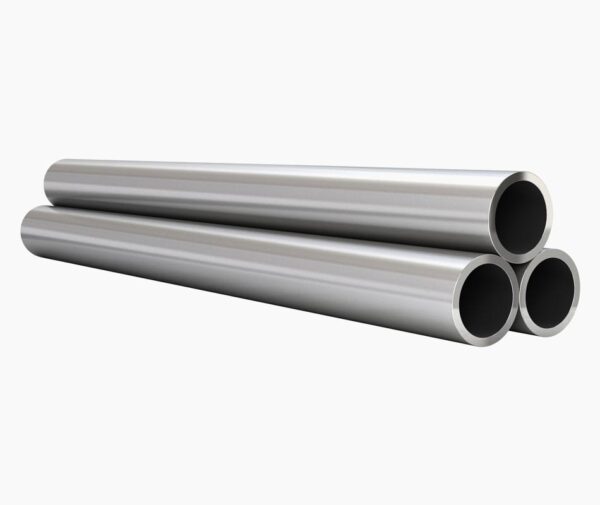Description
The flat rolled metal of the grade retains its magnetic properties under all conditions. Normally, Ferritic steels do not give high temperature strength but with an additional columbium stabilisation in the alloy, there is further enhancing of the high temperature strength, creep-rupture strength and corrosion resistance properties. With appropriate heat treatment like annealing and columbium (niobium) stabilisation, the metal can give exceptional performance under load at elevated temperatures. Hence, properties like deep drawing, good weldability, and good brightness can be retained.
The dual addition of titanium and niobium enhances the welding property by restricting the formation of martensite at the heat affected zone, making the alloy ferritic at all conditions. Moreover, the carbon content (0.03%) reinforces the ductility of the alloy under all conditions. The grade has low work hardening rate, similar to other ferritic alloys, and hence the grade can be suitably deep drawn, cold formed, work stretched and machined. The grade is typically used in the gas exhaust systems due to its capability of resisting oxidation up to 900- 950°C. The chloride resistance of the grade is low, and crevice corrosion is possible depending upon chloride concentrations. With an efficient metal design, appropriate heat treatment, regular maintenance, the alloy can have commendable performance under various environments.
The alpha iron in the grain structure, like other Ferritic grades, imparts its magnetic properties.
Chemical Properties
| Grade | C | Ti | Mn | Si | Cr | S | Nb | P | |
| SS 441 | Min. | – | 0.10 | – | – | 17.50 | – | 0.3+3 | – |
| Max. | 0.03 | 0.60 | 1.00 | 1.00 | 18.50 | 0.015 | 1.00 | 0.04 |
Physical Properties
| Density | 7695 kg/m^3 |
| Melting Point | – |
| Thermal Conductivity @ 70°F | 25 W/ mK |
| Specific Heat | 460 J/ kgK |
| Electrical Resistivity | 0.60 |
| Young’s Modulus x 10ᵌ | 220 |
| Modulus of elasticity | 220 GPa |
General Data
| Standard | SS 441 |
| UNS | S43490 |
| WERKSTOFF NR. | – |
| EN | 1.4509 |
| BS | – |
| GOST | X2CrTiNb18 |
| JIS | – |
| AFNOR | Z 3 CTNb 18 |
Standards Specifications
PIPES & TUBES
| Summary | Standards |
| Chromium and Chromium – Nickel Stainless Steel Plate, Sheet and Strip for Pressure Vessels and for General Applications. | ASTM A240M |
| General Requirements for Flat Rolled Stainless and Heat-Resisting Steel Plate, Sheet and Strip | ASTM 480M |
| Stainless Steel Technical delivery conditions for sheet, plate and strip of corrosion resisting steels for general purposes | EN 10088-2 (1.4509) |
Forms of Supply
Seamless tubes.
Corrosion Resistance
The grade 441 shows improved corrosion resistance than previous ferritic alloy grades. It is exceptionally resistant to stress corrosion cracking, cyclic oxidation, and creep resistance. The high temperature properties of the alloy are commendable due to its grain structure and chemical composition. The titanium and niobium addition in the alloy imparts the intergranular resistance properties to the alloy. Crevice corrosion and pitting resistance are retained by chromium in the alloy.
Heat Treatment
The alloy has low work hardening rate. Due to the exceptional chemical composition, the alloy remains ferritic at all conditions and the martensitic structure is restricted. The heat treatment might be needed to remove internal stresses after the processes. Annealing is usually performed to give the grade its ductility, and ability to perform at elevated temperatures.
Weldability
The stabilising elements in the grade gives the alloy better weldability than previous ferritic grades. Martensite formation is restricted, which makes post weld heat treatment redundant. There might be grain growth due to high temperature at heat affected zone, so low heat input is recommended. Austenitic fillers are normally used in the welding processes. Conventional welding techniques can be suitably used. Gas Tungsten Arc Welding, Tungsten Inert Gas Welding, Electric current resistance welding, Electron beam welding are normally used.
Machining
Conventional machining techniques can be used. It is cold formed conveniently by standard procedures. Its excellent equiaxed grain structure improves its formability.
Applications
Catalytic converter shells, Clamps, Kitchen Catering and appliance, work surfaces, shelving, Automotive exhaust system components, Exhaust system parts, Heat exchangers, Wall panels and claddings, Elevators panels and doors, Tubes.
Possible Grade and Alternatives
GRADE SS 439
| Grade | C | Mn | Si | Fe | Ti | Cr | Ni | |
| SS 439 | Min. | – | – | – | – | – | – | – |
| Max. | 0.070 | 1.00 | 1.0 | 78.33 | 1.1 | 18 | 0.50 |
GRADE SS 18 CR-CB
| Grade | C | Mn | Si | Nb | Ti | Cr | Ni | S | P | N | |
| 18 CR-CB | Min. | – | – | – | 0.3+(9xc | 0.10 | 17.5 | – | – | – | – |
| Max. | 0.03 | 1.00 | 1.0 | 0.9 | 0.50 | 19.5 | 1.00 | 0.03 | 0.04 | 0.03 |


